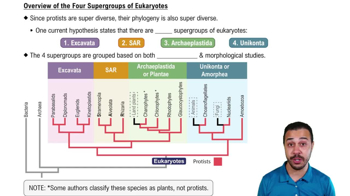Protist Lineages definitions Flashcards
 Back
BackProtist Lineages definitions
1/15
Terms in this set (15)
- ExcavataA major group of unicellular eukaryotes, often lacking mitochondria, reproducing asexually, and including species like Diplomonads and Parabasalids, which use flagella for movement.
- DiplomonadsAnaerobic protists with two nuclei, reduced mitochondria lacking electron transport, and multiple flagella for movement.
- MitochondriaOrganelles in eukaryotic cells that generate ATP through aerobic respiration, often referred to as the cell's "powerhouses." They have their own DNA and are believed to have originated from symbiotic bacteria.
- FlagellaLong, whip-like structures used by cells for locomotion, often found in unicellular organisms and some multicellular organisms, enabling movement through liquid environments.
- ParabasalidsFlagellated protists lacking mitochondria, often parasitic, moving via undulating membranes.
- KinetoplastidsUnicellular eukaryotes with a large mitochondrion containing a kinetoplast, often parasitic, causing diseases like sleeping sickness.
- ChloroplastsOrganelles in plant cells where photosynthesis occurs, converting light energy into chemical energy stored in glucose, using chlorophyll and other pigments.
- ArchaeplastidaA monophyletic group of eukaryotes that includes green algae, red algae, and land plants, originating from a protist that engulfed a cyanobacterium through primary endosymbiosis.
- EndosymbiosisA process where a eukaryotic cell engulfs another cell, leading to a symbiotic relationship, often resulting in the engulfed cell evolving into an organelle like mitochondria or chloroplasts.
- PhycoerythrinA red photosynthetic pigment in red algae that masks chlorophyll's green color, allowing these algae to appear red and adapt to varying light conditions with depth.
- StramenopilaA diverse group of protists characterized by their unique flagella with hair-like projections, including both unicellular and multicellular photosynthetic organisms like diatoms and brown algae.
- DiatomsUnicellular photosynthetic protists encased in silica dioxide shells, contributing significantly to Earth's photosynthesis and carbon cycling.
- CarotenoidsPhotosynthetic pigments in plants and algae that absorb light for photosynthesis, often giving yellow, orange, or red colors, and protect against photooxidative damage.
- AlveolataProtists characterized by membrane-bound sacs (alveoli) beneath their plasma membrane, including dinoflagellates, apicomplexans, and ciliates, often involved in photosynthesis or parasitism.
- ApicomplexansParasitic alveolates with apical complex structures aiding host cell penetration, lacking cilia and flagella, and containing modified plastids from secondary endosymbiosis with red algae.

